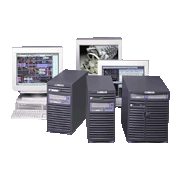Oki Electric announced the OKITAC-9000 series as a way of strengthening its OKI FRAMEWARE, a system framework package. The series consisted of high-performance UNIX systems supplied by Hewlett-Packard on an OEM basis. The machines were positioned to address the requirements of client-server systems in open-source multivendor environments.
Main features of OKI FRAMEWARE:
- (1)Large-scale client server system
- OKI FRAMEWARE provided high-performance servers and workstations to help corporations with relatively expensive distributed-processing systems downsize their core information systems and systems centered on conventional mid-range computers.
- (2)Open-source platform
- By strengthening servers and workstations as well as conventional components, OKI FRAMEWARE provided system solutions for corporate strategic information systems and integrated office systems.
- (3)Multicultural support
- OKI FRAMEWARE offered a rich variety of client server systems with a wide selection of application software packages.
- (4)High-performance online transaction processing
- OKI FRAMEWARE delivered online transaction processing systems with high performance, reliability, and integrity that allowed clients to build large-scale database systems and communication systems.
- (5)PC connectivity
- In order to offer optimal solutions for the development of groupware or distributed applications, OKI FRAMEWARE included LAN Manager X, which maximized the capabilities of network-connected resources.
The OKITAC-9000 series were OEM machines supplied by Hewlett-Packard in continuation of a basic supply agreement reached with Hewlett-Packard in April 1992.
Main features of the OKITAC-9000 series:
- (1)PA-RISC processors
- (2)HP-UX operating system able to run business applications
- (3)Industry standard open-source system (high interconnectivity)
- (4)Ensured backward compatibility throughout the series
Oki Electric came out with the OKITAC-9000 800 line with 13 models (F10, F20, H20, F30, G30, H30, I30, G40, H40, I40, G50, H50, I50) in December 1992. Processor clock frequencies ranged from 32 MHz to 96 MHz.
Oki Electric announced six models for the entry-class OKITAC-9000 D series (D210, D250, D250/2, D310, D350, D350/2) in January 1996. These models had SMP architectures. The D250/2 and the D350/2 each used two PA-7200 (100 MHz) processors. These models scored 6,280 on the SPEC int92 benchmark test.
Oki Electric announced the mid-range K class and the high-end T class, both running on PA-7200 (120 MHz) processors, in February 1996. Again in September 1996, Oki Electric announced upgraded K series and D series models with PA-8000 (160 MHz ? 180 MHz) processors. Around the same time, Oki Electric announced its UNIX workstations, which were equipped with PA-7300LC (132 MHz ? 160 MHz) processors.
Oki Electric continued to actively expand the series — the V2250 with PA-8200 (240 MHz) processors in 1998 and the Superdome with PA-8600 (552 MHz) processors in 2000 — to provide solution servers for net payments, Web transactions, ERP, and other applications.
Related to this series were the OKITAC S 4/630MP, 4/670MP, and 4/690MP models that Oki Electric announced in October 1991. These were OEM machines supplied by Sun Microsystems Japan. They featured 40 MHz SPARC processors and the four-processor model reached a 90.3 SPECint throughput.


